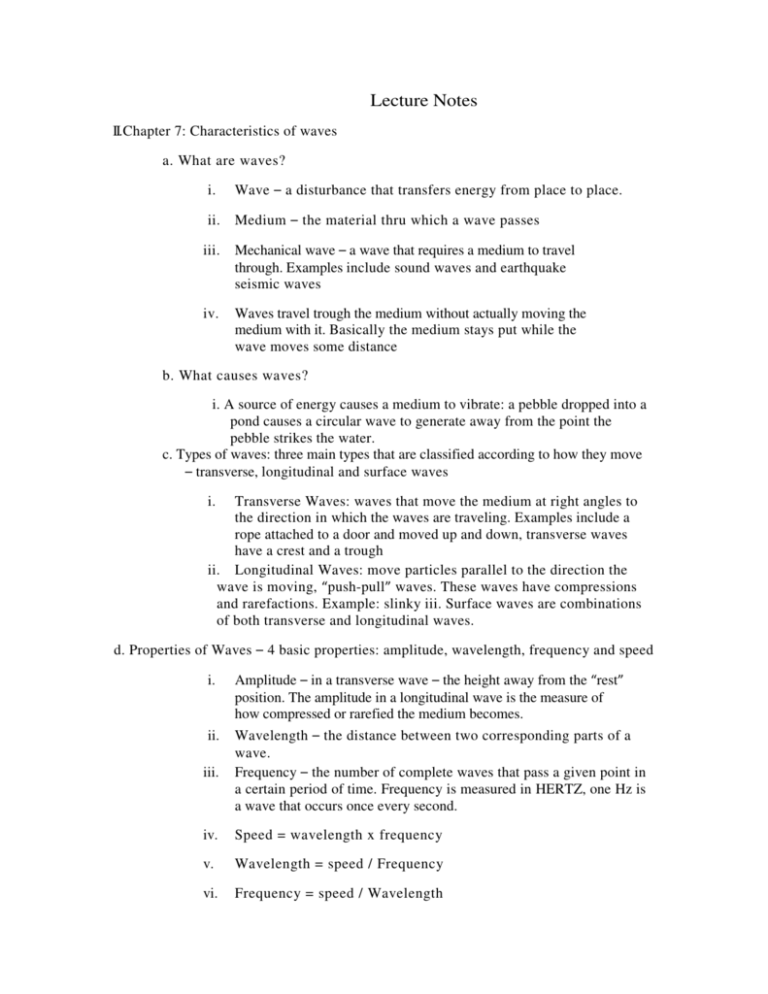Chapter 7 - Characteristics of Waves
advertisement

Lecture Notes II.Chapter 7: Characteristics of waves a. What are waves? i. Wave – a disturbance that transfers energy from place to place. ii. Medium – the material thru which a wave passes iii. Mechanical wave – a wave that requires a medium to travel through. Examples include sound waves and earthquake seismic waves iv. Waves travel trough the medium without actually moving the medium with it. Basically the medium stays put while the wave moves some distance b. What causes waves? i. A source of energy causes a medium to vibrate: a pebble dropped into a pond causes a circular wave to generate away from the point the pebble strikes the water. c. Types of waves: three main types that are classified according to how they move – transverse, longitudinal and surface waves i. Transverse Waves: waves that move the medium at right angles to the direction in which the waves are traveling. Examples include a rope attached to a door and moved up and down, transverse waves have a crest and a trough ii. Longitudinal Waves: move particles parallel to the direction the wave is moving, “push-pull” waves. These waves have compressions and rarefactions. Example: slinky iii. Surface waves are combinations of both transverse and longitudinal waves. d. Properties of Waves – 4 basic properties: amplitude, wavelength, frequency and speed i. ii. iii. Amplitude – in a transverse wave – the height away from the “rest” position. The amplitude in a longitudinal wave is the measure of how compressed or rarefied the medium becomes. Wavelength – the distance between two corresponding parts of a wave. Frequency – the number of complete waves that pass a given point in a certain period of time. Frequency is measured in HERTZ, one Hz is a wave that occurs once every second. iv. Speed = wavelength x frequency v. Wavelength = speed / Frequency vi. Frequency = speed / Wavelength e. Interactions of waves i. Reflection – Bounce back wave 1. Angle of incidence is the angle of the wave coming into the object reflecting the wave. 2. Angle of Reflection is the angle bouncing off and going away from the object. ii. Refraction – The bending of a wave due to the wave moving from one type of medium into another. iii. Diffraction – Wave passing a barrier or going through a hole in a barrier bends and causes the wave to wrap around the barrier iv. Interference – when two or more waves meet, they interact. This interaction is called interference. 1. Constructive interference – the combining of waves to cause higher amplitude of any of the original waves. 2. Destructive Interference – when the combining of the waves produce a new wave with a smaller amplitude than the beginning waves v. Standing waves – the combining of the incoming and reflected wave so that the resultant appears to be standing still 1. node – the point where Constructive Interference and Destructive Interference cause an amplitude of zero on the standing wave. 2. antinode – the point where Constructive Interference and Destructive Interference of a standing wave are represented by the crest and the trough. 3. Resonance – the point where vibrations traveling thru and object matches the natural vibrations of an object. a. Ie an opera singer hitting a note and shattering a crystal glass. f. Seismic Waves – waves caused by the release of energy due to earthquakes composed of P primary waves, S secondary waves and the surface waves i. P waves – Primary waves are the fastest moving waves, they travel thru solids and liquids, Push-Pull Waves AKA Longitudinal waves ii. S Waves – Secondary Waves are slower than primary waves, they cannot travel thru liquid and are Longitudinal waves. iii. Surface wave – the combination on the Earth’s surface of Primary and Secondary waves







